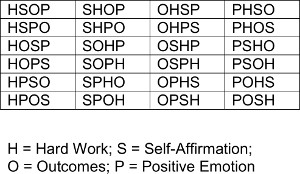개체 내 반복 측정 설계
Overview
출처: 게리 레반도프스키,데이브 스트로메츠, 나탈리 시아로코-몬머스 대학교 의 연구소
내과목 또는 반복 조치, 디자인은 모든 참가자가 치료의 모든 수준, 즉,모든 독립적 인 변수를받을 수있는 실험 적 디자인입니다. 예를 들어, 사탕 맛 테스트에서 연구원은 모든 참가자가 각 유형의 사탕을 맛보고 평가하기를 원할 것입니다.
이 비디오는 다양한 동기 부여메시지(예:노력, 자기 긍정, 결과 및 긍정적인 영향)가 육체적 노력을 발휘하려는 의지에 미치는 영향을 조사하는 내과목실험(예:여러 가지 변형 또는 수준으로 독립적인 변수가 있는 경우)을 보여줍니다. 피험자 내 디자인으로 참가자는 동기 부여 메시지의 네 가지 유형을 각각 읽은 다음 물리적 인 노력을 측정하기 위해 가중치를 들어 올립니다. 이 비디오는 연구원이 반복 측정 실험을 수행하는 방법에 대한 개요를 제공함으로써 시청자가 연구에서 가능한 모든 조건이 발생하는지 확인하는 체계적인 접근 방식을 포함하는 카운터 밸런싱을 통해 주문 효과를 해결하는 방법을 볼 수 있습니다.
심리학 연구는 종종 다른 과학연구보다 더 높은 표본 크기를 사용합니다. 많은 수의 참가자가 연구 중인 인구가 더 잘 표현되고 인간의 행동을 연구하는 것과 함께 오차 범위가 충분히 해결되도록 하는 데 도움이 됩니다. 이 비디오에서는 한 명의 참가자만 사용하여 이 실험을 시연합니다. 그러나, 결과에 표현된 바와 같이, 우리는 실험의 결론에 도달하기 위하여 총 72명의 참가자를 이용했습니다.
Procedure
1. 주요 변수를 정의합니다.
- 동기 부여 메시지의 운영정의(즉,연구원이 개념에 의해 정확히 무엇을 의미하는지에 대한 명확한 설명)를 만듭니다.
- 이 실험의 목적을 위해, 동기 부여 메시지는 사람의 행동에 활력을 불어넣기 위해 고안된 이미지와 문구의 조합이며, 여기에 조작된 일련의 이미지와 함께 노력, 자기 긍정, 결과/성공, 일반적인 긍정적인 감정/감정(그림1 - 4)에초점을 맞춘 인용문을 통해 인용을 강화하는 것으로 간주됩니다.

그림 1: 열심히 일하는 동기 부여 메시지와 함께 표시된 이미지입니다.
그림 2: 자기 긍정 동기 부
- 이 실험의 목적을 위해, 동기 부여 메시지는 사람의 행동에 활력을 불어넣기 위해 고안된 이미지와 문구의 조합이며, 여기에 조작된 일련의 이미지와 함께 노력, 자기 긍정, 결과/성공, 일반적인 긍정적인 감정/감정(그림1 - 4)에초점을 맞춘 인용문을 통해 인용을 강화하는 것으로 간주됩니다.
Results
이 절차는 24개의 불균형 주문에서 세 번 반복되었기 때문에 총 72명의 참가자로부터 데이터를 수집했습니다. 결과가 신뢰할 수 있도록 많은 수의 참가자가 필요합니다. 이 연구가 단지 몇몇 참가자를 사용하여 수행되었다면, 결과가 훨씬 다르고 더 큰 인구를 반영하지 않았을 가능성이 높습니다.
물리적 인 노력에 동기 부여 메시지 사이에 차이가 있는지 확인하기 위해 분산 (...
Application and Summary
References
- Acevedo, B. P., Aron, A., Fisher, H. E., & Brown, L. L. Neural correlates of long-term intense romantic love. Social Cognitive And Affective Neuroscience. 8 (2), 145-159. doi:10.1093/scan/nsq092 (2012).
Tags
건너뛰기...
이 컬렉션의 비디오:

Now Playing
개체 내 반복 측정 설계
Experimental Psychology
23.1K Views

이론에서 설계까지: 실험 디자인에서 창의성의 역할
Experimental Psychology
18.7K Views

심리학 연구의 윤리
Experimental Psychology
29.3K Views

실험에서 사실주의
Experimental Psychology
8.3K Views

실험 심리학에 대한 관점
Experimental Psychology
5.7K Views

파일럿 검사
Experimental Psychology
10.3K Views

관찰 연구
Experimental Psychology
13.2K Views

간단 실험: 두 그룹 설계
Experimental Psychology
74.5K Views

다중 그룹 실험
Experimental Psychology
22.9K Views

요인 실험
Experimental Psychology
73.2K Views

자기 보고 vs 재활용 행동 측정
Experimental Psychology
11.8K Views

심리적 실험의 신뢰성
Experimental Psychology
8.6K Views

연구에서의 위약
Experimental Psychology
11.6K Views

실구현를 통한 독립 변수 조작
Experimental Psychology
8.5K Views

공모자를 사용한 실험
Experimental Psychology
17.8K Views
Copyright © 2025 MyJoVE Corporation. 판권 소유



